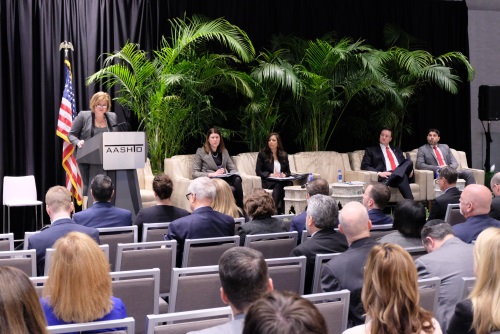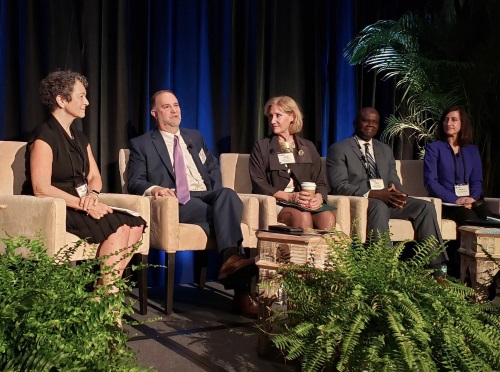Leaders from key federal transportation departments re-emphasized how they are focusing on improving infrastructure and safety during a roundtable session at the American Association of State Highway and Transportation Officials annual Washington Briefing on February 26.

“Safety is a focus that unites the entire U.S. Department of Transportation across all of its agencies,” explained Mala Parker, deputy administrator of the Federal Highway Administration. “I know we also all agree that we need to improve our nation’s transportation infrastructure. And FHWA is in a unique leadership position to identify new innovations – drones, high tech materials, and automated transportation – to do that. We’re evaluating them all at FHWA.”
She added that the agency is “committed” to analyze and implement more innovations related to pedestrian safety, as 2018 Fatality Analysis Reporting System or FARS data indicated an increase in pedestrian fatalities. “We’ve engaged a STEP [Safe Transportation for Every Pedestrian] initiative to deploy engineering such as raised crosswalks, signal traffic timing changes, etc., to improve pedestrian safety.”

K. Jane Williams, acting administrator of Federal Transit Administration, said her agency is focused on both ensuring greater safety for transit users but also on building infrastructure more efficiently; investing equally in both urban and rural American public transportation systems.
We appreciate the strong partnership we have with state DOTs to help support transit agencies – especially the smaller ones – with both capital and operational funding,” she said. “That’s important as [transit] rider expectations continue to expand. [They want] seamless transfer between all modes, limited wait times, and better/simpler methods of payment.”
That’s why she hopes state DOTs applying for transit grants “think big, think outside the box, and think innovatively. We do not want to limit the creativity of states and industry stakeholders.”

Morteza Farajian, executive director of the Build America Bureau at USDOT, reiterated the need for “innovation” is growing in the transportation sector, particularly in terms of how to pay for transportation projects.
“State DOTs are using technology, data, and intelligent transportation solutions in new ways – all new disciplines that they did not have 10 to 20 years ago, which require new [workforce] skill sets,” he said. “Innovative financial models will require the same thing.”
Farajian added that his agency’s credit programs “are not oversubscribed” and “we can offer very competitive rates, terms, and conditions to help fund projects. No matter if the project is small or large, rural or urban, we can talk about how to fund it — if there are bridges you need to replace. What is really important is that we have programs that can benefit you.”
Another area of federal-level focus is “breaking down silos and barriers” in order to more fully address “common problems when it comes to safety,” said James Owens, acting administrator of the National Highway Traffic Safety Administration.

“No one group or person can solve the issue of roadway fatalities – it will take all of us working together,” he explained. “To move towards zero deaths, to reduce fatalities and injuries, safety must be paramount – it cannot be an afterthought in the [roadway] design process. But we must also recognize that highway safety problems have an understated complexity that cannot be solved with a single approach.”
Two of the “most egregious” safety problems in transportation today, Owens noted, are lack of seatbelt use and distracted driving.
“And where rural road safety is concerned, the statistics are particularly alarming. According to the Census, 19 percent of our nation’s population lives in rural areas, but 44 percent of [highway] fatalities are there,” he said.

“We want to give more flexibility to the states to address [safety] problems because they know how to best identify them – issues such as impaired driving, distracted driving, improving pedestrian safety, and increasing seatbelt use,” Owens noted.
While he said the transportation industry has “a huge opportunity to change the status quo” today in terms of making American roads safer than ever, there is “no silver bullet” when it comes to safety.
“We know human error is responsible for 90 percent of [vehicle] crashes; this has been a stubborn problem for a long time,” Owens noted. “We also know vehicles are increasingly being built not just to mitigate crashes but avoid them altogether – and that will help us compensate for human error.”



